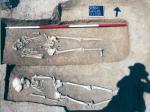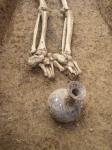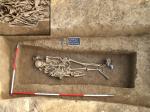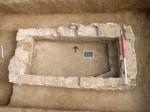Summary (English)
From 1999 archaeological research of a Late Roman cemetery has been going on at the site of Štrbinci near Đakovo, the probable location of the settlement Certissia. So far 115 late Roman interments have been excavated. The 2005 campaign took place from 6th to 23rd June. The area excavated in 2005 comprised 135 square metres. The cultural layer started from the very surface and reached the relative depth of 0,50 – 2,60 m, comprising 4 cultural/chronological layers: prehistoric, late Roman, 16th -17th century, recent. Of the total of 26 archaeological features there were 2 Neolithic pits and 1 ditch, 1 pit comprising pottery from the 16th -17th centuries, one recent pit of unidentified nature and 4 additional pits of unidentified nature and chronology; the remainder yielded 17 late Roman burials. They comprised 11 graves in earth pits, 2 burials in wooden coffins and earth pits and 4 mortared grave vaults. The masonry of one of them was at one point preserved up to the height of 1,30 m, while the remainder three were completely crushed, the only solid traces being scanty sporadic imprints of the walls in the mortar. Since only a small quantity of crushed masonry was preserved in the fill of each of them, it should be supposed that this was caused by the search for usable building material in past times. Burials in wooden coffins were witnessed not only by residual nails, but also by traces of rotten wood at places around the skeletons. Earth pits are rectangular or sub-rectangular, of various measurements (approximate depth varying from 0,30 m to 0,65 m), and all graves but one were single. All of them were extended supine burials. The orientation was in most cases NW-SE, with the exception of grave vaults 109 and 114 whose orientation was N-S, this being a new phenomenon in the whole of the so far excavated portion of the cemetery. The position of hands varied: straight at sides; crossed on pelvis or abdomen; one on pelvis and another straight; one on pelvis and another lifted to breast or shoulder. The state of preservation of the skeletons varies considerably – from excellent (rarely) to complete decomposition. In the 11 of the total of 17 burials grave goods were found, featuring 25 artefacts such glass vessels (beakers, jugs, bottles, balsamaria), glass and copper alloy beads, copper alloy and bone bracelets, one copper alloy earring and one copper alloy pendant, wooden casket copper alloy fittings as well as copper alloy coins. The state of preservation varies from very good to extremely bad, the latter particularly when glass vessels are concerned (B. Migotti 2006, Hrvatski arheološki godišnjak 2/2005, 19–21).
- Branka Migotti
Director
- Branka Migotti
Team
- Tino Leleković
- Danijela Roksandić
- Natalija Gjeri
- Silvio Stanković
Research Body
- Muzej Đakovštine
- Odsjek za arheologiju Hrvatske akademije znanosti i umjetnosti






![Download [PDF]](/excavation/skins/fasti/images/results/download_sml.png)


